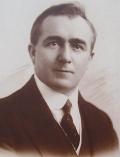The son of entertainer and theatrical entrepreneur, John Fuller Snr, John Jnr performed in his father's minstrel troupe on weekends during his youth and in 1891 came to Australia with most of the members of his family. While attending school in Collingwood he continued to work in the theatre, securing a position as call-boy in Williamson's Royal Comic Opera Company for three years and playing any suitable juvenile parts that came his way. After the family moved to New Zealand in 1894 John took on the dual roles of singer and lantern show manipulator for their popular concerts. He and his older brother Benjamin also took on increasing mangerial responsibilities in the family's expanding operations.
In 1912 the Fuller brothers established a permanent base of operations in Australia by buying out James Brennan's circuit. John continued to live in Wellington, however, and between 1911 and 1916 also served on the city's council. Trading as John Fuller and Sons (but more commonly known as Fullers' Theatres), the company soon established a vaudeville empire on both sides of the Tasman, engaging many of the region's best acts at some stage of their careers. Among the best remembered performers to have been associated with the Fullers were: '
Stiffy and Mo' (
Nat Phillips and
Roy Rene),
Fred Bluett,
George Wallace,
Jim Gerald,
Bert Le Blanc,
Amy Rochelle,
Nellie Kolle,
Leonard Nelson, and
Mike Connors and
Queenie PaulIn 1916 John moved to Australia, leaving another brother, Walter, in charge of the New Zealand operations. Although Benjamin had by this time become very much the company's figurehead, and the originator of the ideas, John was reportedly the one who made these ideas work. The early 1920s saw the brothers go into partnership with
Hugh J. Ward (1923-1926) to produce musical comedies and in 1929 they became directors of the newly formed Australian Broadcasting Co. Five years later the pair decided to go their separate ways and divided their company assets between them. Although John moved almost exclusively into real estate, he nevertheless retained control of the St James Theatre in Sydney. He retired from his business activities in 1944 and died in St Luke's Hospital, Darlinghurst on 26 September 1959.

